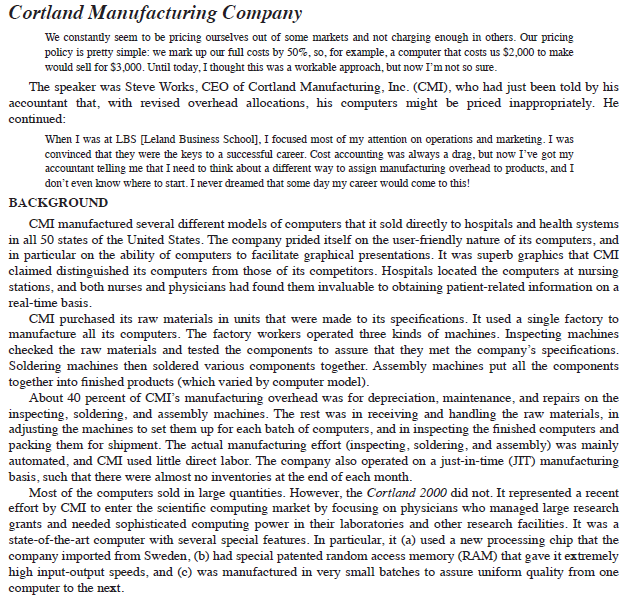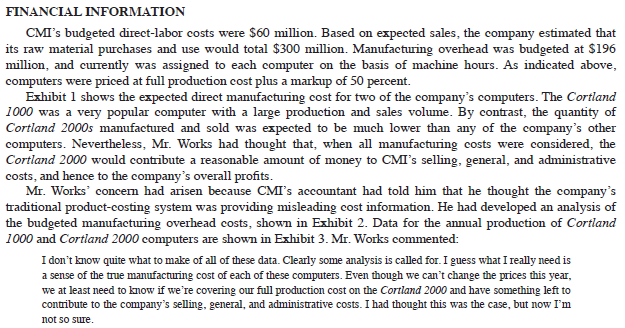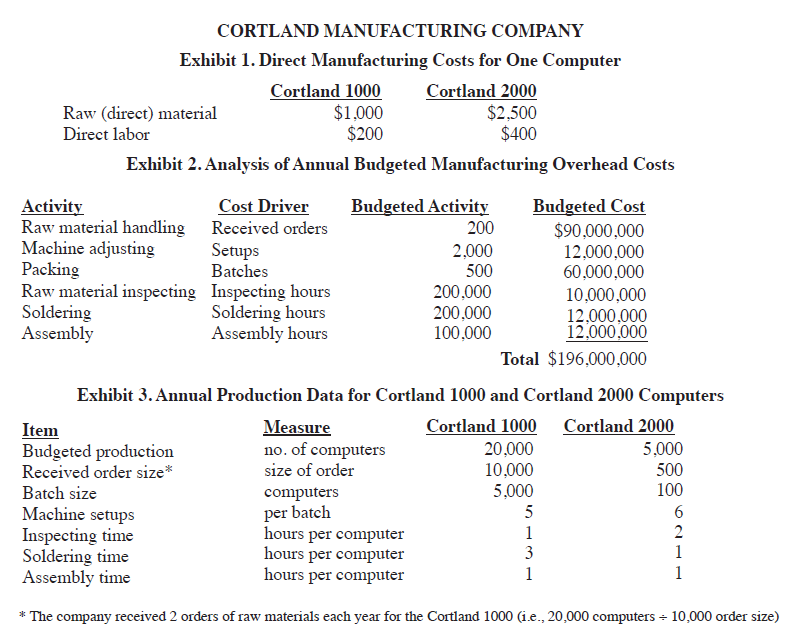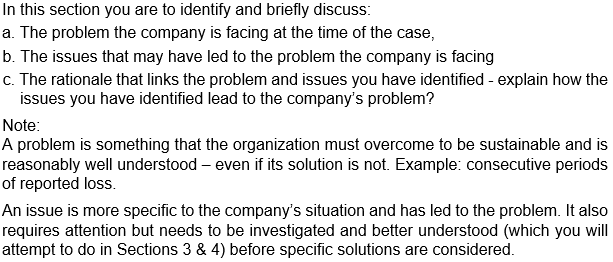



Cortland Manufacturing Company We constantly seem to be pricing ourselves out of some markets and not charging enough in others. Our pricing policy is pretty simple: we mark up our full costs by 50%, so, for example, a computer that costs us $2,000 to make would sell for $3,000. Until today, I thought this was a workable approach, but now I'm not so sure. The speaker was Steve Works, CEO of Cortland Manufacturing, Inc. (CMI), who had just been told by his accountant that, with revised overhead allocations, his computers might be priced inappropriately. He continued When I was at LBS Leland Business School], I focused most of my attention on operations and marketing. I was convinced that they were the keys to a successful career. Cost accounting was always a drag, but now I've got my accountant telling me that I need to think about a different way to assign manufacturing overhead to products, and I don't even know where to start. I never dreamed that some day my career would come to this! BACKGROUND CMI manufactured several different models of computers that it sold directly to hospitals and health systems in all 50 states of the United States. The company prided itself on the user-friendly nature of its computers, and in particular on the ability of computers to facilitate graphical presentations. It was superb graphics that CMI claimed distinguished its computers from those of its competitors. Hospitals located the computers at nursing stations, and both nurses and physicians had found them invaluable to obtaining patient-related information on a real-time basis. CMI purchased its raw materials in units that were made to its specifications. It used a single factory to manufacture all its computers. The factory workers operated three kinds of machines. Inspecting machines checked the raw materials and tested the components to assure that they met the company's specifications. Soldering machines then soldered various components together. Assembly machines put all the components together into finished products (which varied by computer model). About 40 percent of CMI's manufacturing overhead was for depreciation, maintenance, and repairs on the inspecting, soldering, and assembly machines. The rest was in receiving and handling the raw materials, in adjusting the machines to set them up for each batch of computers, and in inspecting the finished computers and packing them for shipment. The actual manufacturing effort (inspecting, soldering, and assembly) was mainly automated, and CMI used little direct labor. The company also operated on a just-in-time (JIT) manufacturing basis, such that there were almost no inventories at the end of each month. Most of the computers sold in large quantities. However, the Cortland 2000 did not. It represented a recent effort by CMI to enter the scientific computing market by focusing on physicians who managed large research grants and needed sophisticated computing power in their laboratories and other research facilities. It was a state-of-the-art computer with several special features. In particular, it (a) used a new processing chip that the company imported from Sweden, (b) had special patented random access memory (RAM) that gave it extremely high input-output speeds, and (c) was manufactured in very small batches to assure uniform quality from one computer to the next. FINANCIAL INFORMATION CMI's budgeted direct-labor costs were $60 million. Based on expected sales, the company estimated that its raw material purchases and use would total $300 million. Manufacturing overhead was budgeted at $196 million, and curently was assigned to each computer on the basis of machine hours. As indicated above, computers were priced at full production cost plus a markup of 50 percent. Exhibit 1 shows the expected direct manufacturing cost for two of the company's computers. The Cortland 1000 was a very popular computer with a large production and sales volume. By contrast, the quantity of Cortland 2000s manufactured and sold was expected to be much lower than any of the company's other computers. Nevertheless, Mr. Works had thought that, when all manufacturing costs were considered, the Cortland 2000 would contribute a reasonable amount of money to CMI's selling, general, and costs, and hence to the company's overall profits. Mr. Works' concem had arisen because CMI's accountant had told him that he thought the company's traditional product-costing system was providing misleading cost information. He had developed an analysis of the budgeted manufacturing overhead costs, shown in Exhibit 2. Data for the annual production of Cortland 1000 and Cortland 2000 computers are shown in Exhibit 3. Mr. Works commented: I don't know quite what to make of all of these data. Clearly some analysis is called for. I guess what I really need is a sense of the true manufacturing cost of each of these computers. Even though we can't change the prices this year, we at least need to know if we're covering our full production cost on the Cortland 2000 and have something left to contribute to the company's selling, general, and administrative costs. I had thought this was the case, but now I'm not so sure. CORTLAND MANUFACTURING COMPANY Exhibit 1. Direct Manufacturing Costs for One Computer Cortland 1000 Cortland 2000 Raw (direct) material $1.000 $2.500 Direct labor $200 $400 Exhibit 2. Analysis of Annual Budgeted Manufacturing Overhead Costs 200 Activity Cost Driver Raw material handling Received orders Machine adjusting Setups Packing Batches Raw material inspecting Inspecting hours Soldering Soldering hours Assembly Assembly hours Budgeted Activity Budgeted Cost $90.000.000 2.000 12.000.000 500 60.000.000 200.000 10.000.000 200.000 12.000.000 100,000 12.000.000 Total $196,000,000 500 Exhibit 3. Annual Production Data for Cortland 1000 and Cortland 2000 Computers Item Measure Cortland 1000 Cortland 2000 Budgeted production no. of computers 20.000 5.000 Received order size* size of order 10.000 Batch size computers 5,000 Machine setups per batch Inspecting time hours per computer Soldering time hours per computer Assembly time hours per computer 100 * The company received 2 orders of raw materials each year for the Cortland 1000 (i.e., 20,000 computers = 10,000 order size) In this section you are to identify and briefly discuss: a. The problem the company is facing at the time of the case, b. The issues that may have led to the problem the company is facing c. The rationale that links the problem and issues you have identified - explain how the issues you have identified lead to the company's problem? Note: A problem is something that the organization must overcome to be sustainable and is reasonably well understood - even if its solution is not. Example: consecutive periods of reported loss. An issue is more specific to the company's situation and has led to the problem. It also requires attention but needs to be investigated and better understood (which you will attempt to do in Sections 3 & 4) before specific solutions are considered. Cortland Manufacturing Company We constantly seem to be pricing ourselves out of some markets and not charging enough in others. Our pricing policy is pretty simple: we mark up our full costs by 50%, so, for example, a computer that costs us $2,000 to make would sell for $3,000. Until today, I thought this was a workable approach, but now I'm not so sure. The speaker was Steve Works, CEO of Cortland Manufacturing, Inc. (CMI), who had just been told by his accountant that, with revised overhead allocations, his computers might be priced inappropriately. He continued When I was at LBS Leland Business School], I focused most of my attention on operations and marketing. I was convinced that they were the keys to a successful career. Cost accounting was always a drag, but now I've got my accountant telling me that I need to think about a different way to assign manufacturing overhead to products, and I don't even know where to start. I never dreamed that some day my career would come to this! BACKGROUND CMI manufactured several different models of computers that it sold directly to hospitals and health systems in all 50 states of the United States. The company prided itself on the user-friendly nature of its computers, and in particular on the ability of computers to facilitate graphical presentations. It was superb graphics that CMI claimed distinguished its computers from those of its competitors. Hospitals located the computers at nursing stations, and both nurses and physicians had found them invaluable to obtaining patient-related information on a real-time basis. CMI purchased its raw materials in units that were made to its specifications. It used a single factory to manufacture all its computers. The factory workers operated three kinds of machines. Inspecting machines checked the raw materials and tested the components to assure that they met the company's specifications. Soldering machines then soldered various components together. Assembly machines put all the components together into finished products (which varied by computer model). About 40 percent of CMI's manufacturing overhead was for depreciation, maintenance, and repairs on the inspecting, soldering, and assembly machines. The rest was in receiving and handling the raw materials, in adjusting the machines to set them up for each batch of computers, and in inspecting the finished computers and packing them for shipment. The actual manufacturing effort (inspecting, soldering, and assembly) was mainly automated, and CMI used little direct labor. The company also operated on a just-in-time (JIT) manufacturing basis, such that there were almost no inventories at the end of each month. Most of the computers sold in large quantities. However, the Cortland 2000 did not. It represented a recent effort by CMI to enter the scientific computing market by focusing on physicians who managed large research grants and needed sophisticated computing power in their laboratories and other research facilities. It was a state-of-the-art computer with several special features. In particular, it (a) used a new processing chip that the company imported from Sweden, (b) had special patented random access memory (RAM) that gave it extremely high input-output speeds, and (c) was manufactured in very small batches to assure uniform quality from one computer to the next. FINANCIAL INFORMATION CMI's budgeted direct-labor costs were $60 million. Based on expected sales, the company estimated that its raw material purchases and use would total $300 million. Manufacturing overhead was budgeted at $196 million, and curently was assigned to each computer on the basis of machine hours. As indicated above, computers were priced at full production cost plus a markup of 50 percent. Exhibit 1 shows the expected direct manufacturing cost for two of the company's computers. The Cortland 1000 was a very popular computer with a large production and sales volume. By contrast, the quantity of Cortland 2000s manufactured and sold was expected to be much lower than any of the company's other computers. Nevertheless, Mr. Works had thought that, when all manufacturing costs were considered, the Cortland 2000 would contribute a reasonable amount of money to CMI's selling, general, and costs, and hence to the company's overall profits. Mr. Works' concem had arisen because CMI's accountant had told him that he thought the company's traditional product-costing system was providing misleading cost information. He had developed an analysis of the budgeted manufacturing overhead costs, shown in Exhibit 2. Data for the annual production of Cortland 1000 and Cortland 2000 computers are shown in Exhibit 3. Mr. Works commented: I don't know quite what to make of all of these data. Clearly some analysis is called for. I guess what I really need is a sense of the true manufacturing cost of each of these computers. Even though we can't change the prices this year, we at least need to know if we're covering our full production cost on the Cortland 2000 and have something left to contribute to the company's selling, general, and administrative costs. I had thought this was the case, but now I'm not so sure. CORTLAND MANUFACTURING COMPANY Exhibit 1. Direct Manufacturing Costs for One Computer Cortland 1000 Cortland 2000 Raw (direct) material $1.000 $2.500 Direct labor $200 $400 Exhibit 2. Analysis of Annual Budgeted Manufacturing Overhead Costs 200 Activity Cost Driver Raw material handling Received orders Machine adjusting Setups Packing Batches Raw material inspecting Inspecting hours Soldering Soldering hours Assembly Assembly hours Budgeted Activity Budgeted Cost $90.000.000 2.000 12.000.000 500 60.000.000 200.000 10.000.000 200.000 12.000.000 100,000 12.000.000 Total $196,000,000 500 Exhibit 3. Annual Production Data for Cortland 1000 and Cortland 2000 Computers Item Measure Cortland 1000 Cortland 2000 Budgeted production no. of computers 20.000 5.000 Received order size* size of order 10.000 Batch size computers 5,000 Machine setups per batch Inspecting time hours per computer Soldering time hours per computer Assembly time hours per computer 100 * The company received 2 orders of raw materials each year for the Cortland 1000 (i.e., 20,000 computers = 10,000 order size) In this section you are to identify and briefly discuss: a. The problem the company is facing at the time of the case, b. The issues that may have led to the problem the company is facing c. The rationale that links the problem and issues you have identified - explain how the issues you have identified lead to the company's problem? Note: A problem is something that the organization must overcome to be sustainable and is reasonably well understood - even if its solution is not. Example: consecutive periods of reported loss. An issue is more specific to the company's situation and has led to the problem. It also requires attention but needs to be investigated and better understood (which you will attempt to do in Sections 3 & 4) before specific solutions are considered










